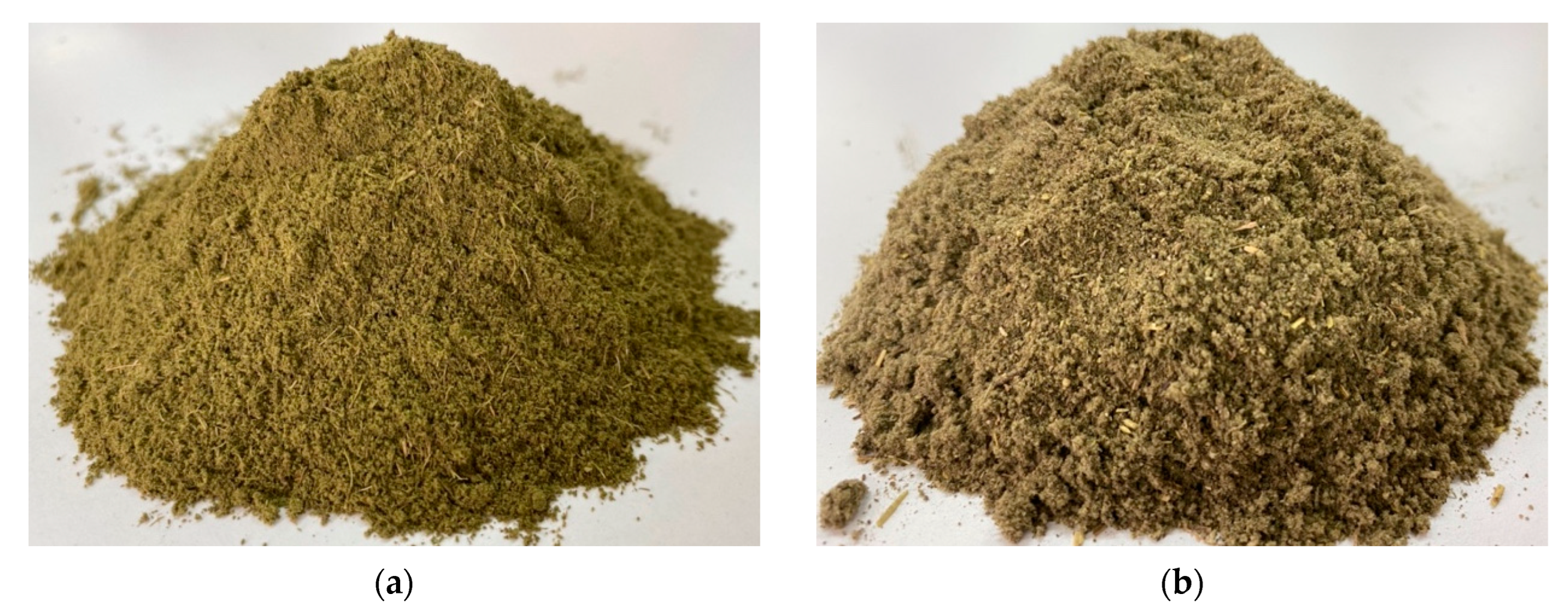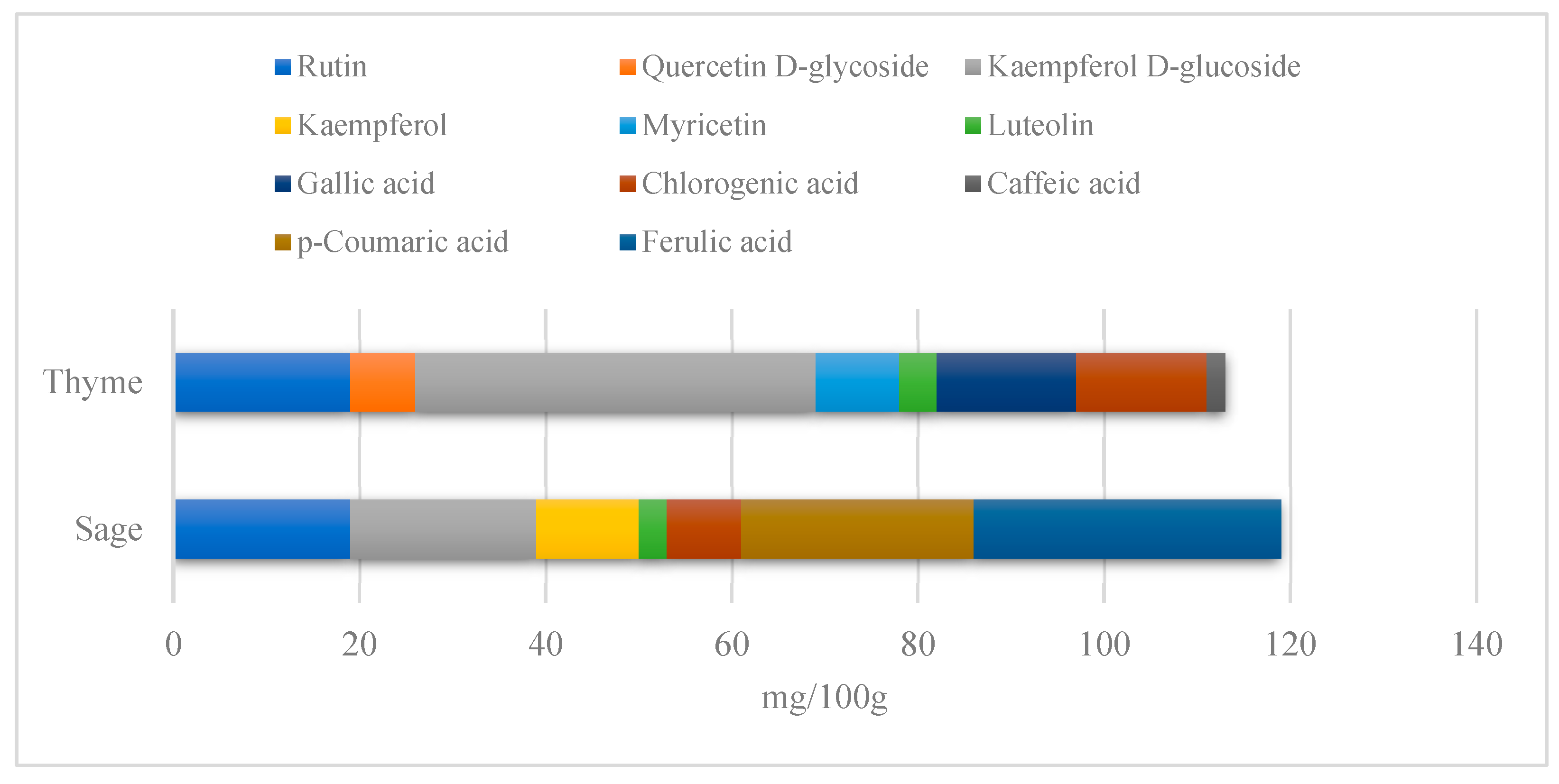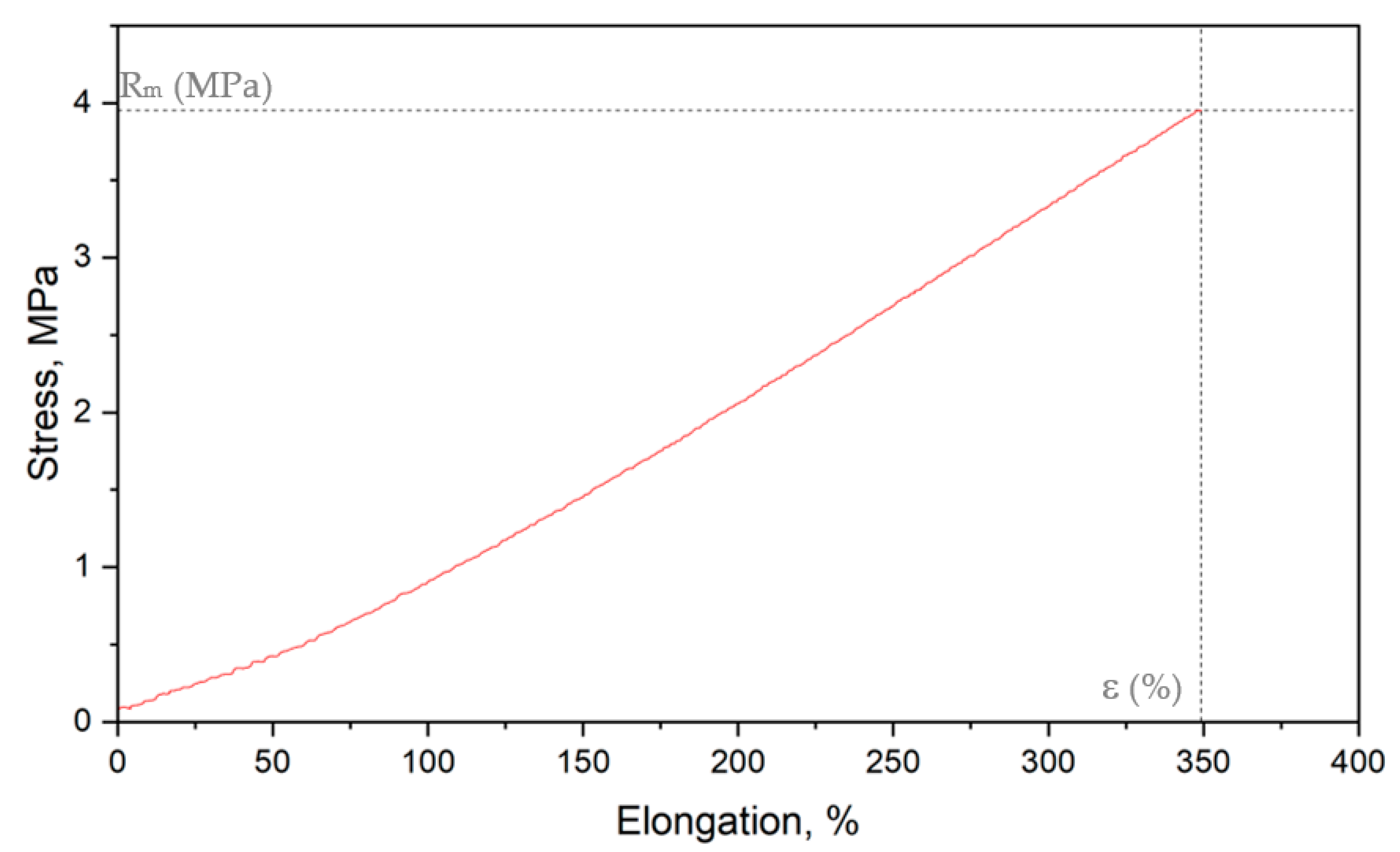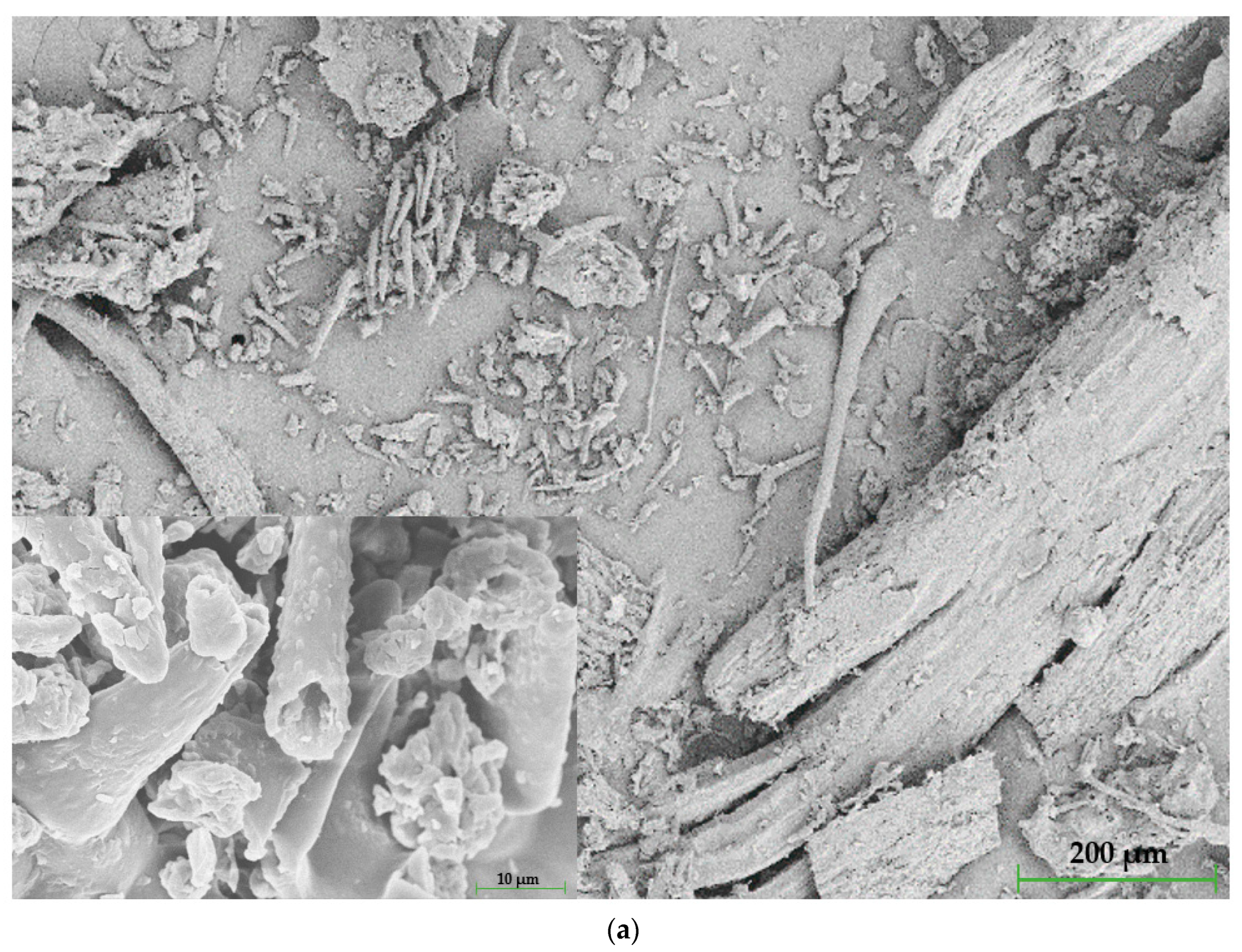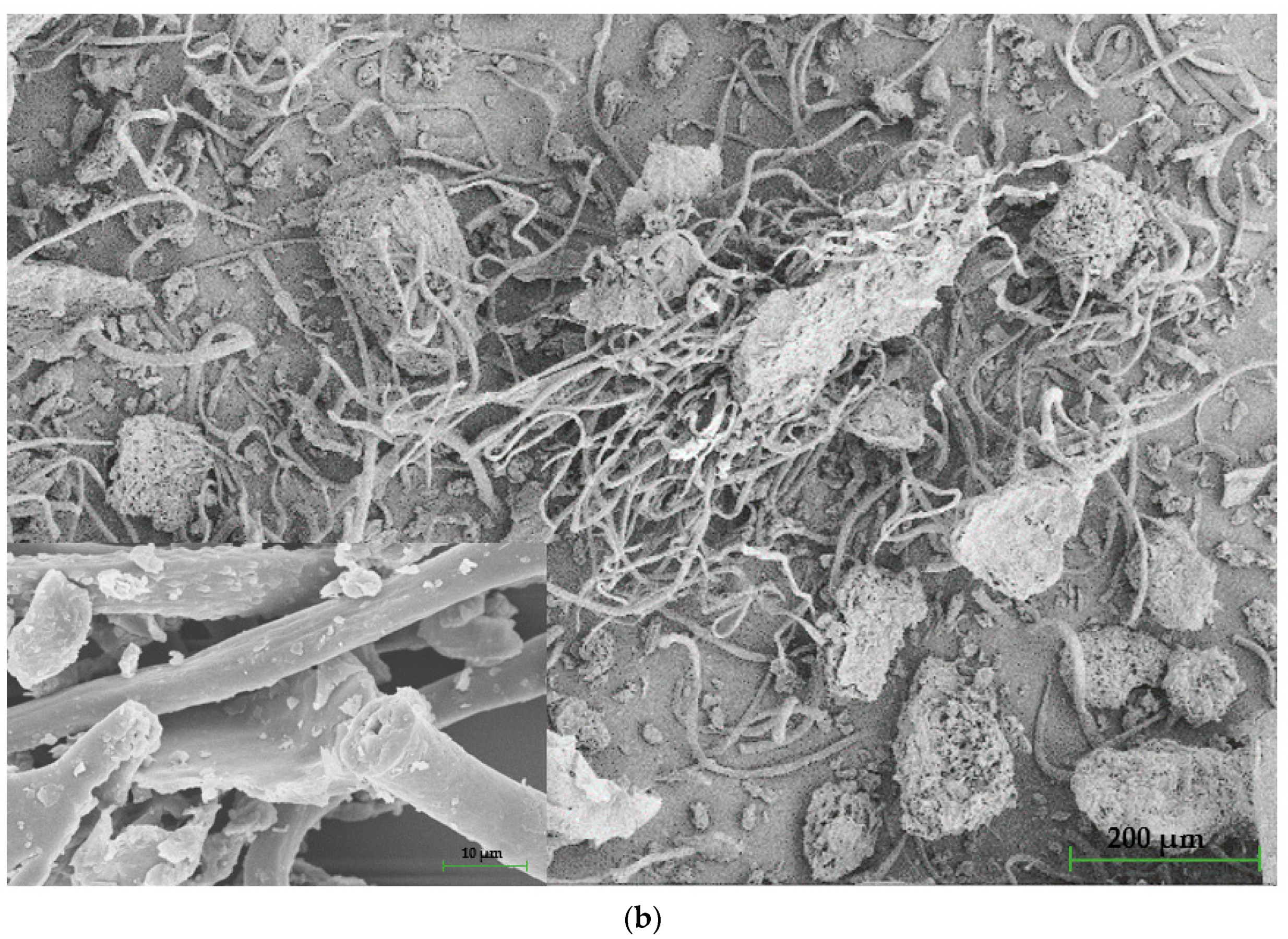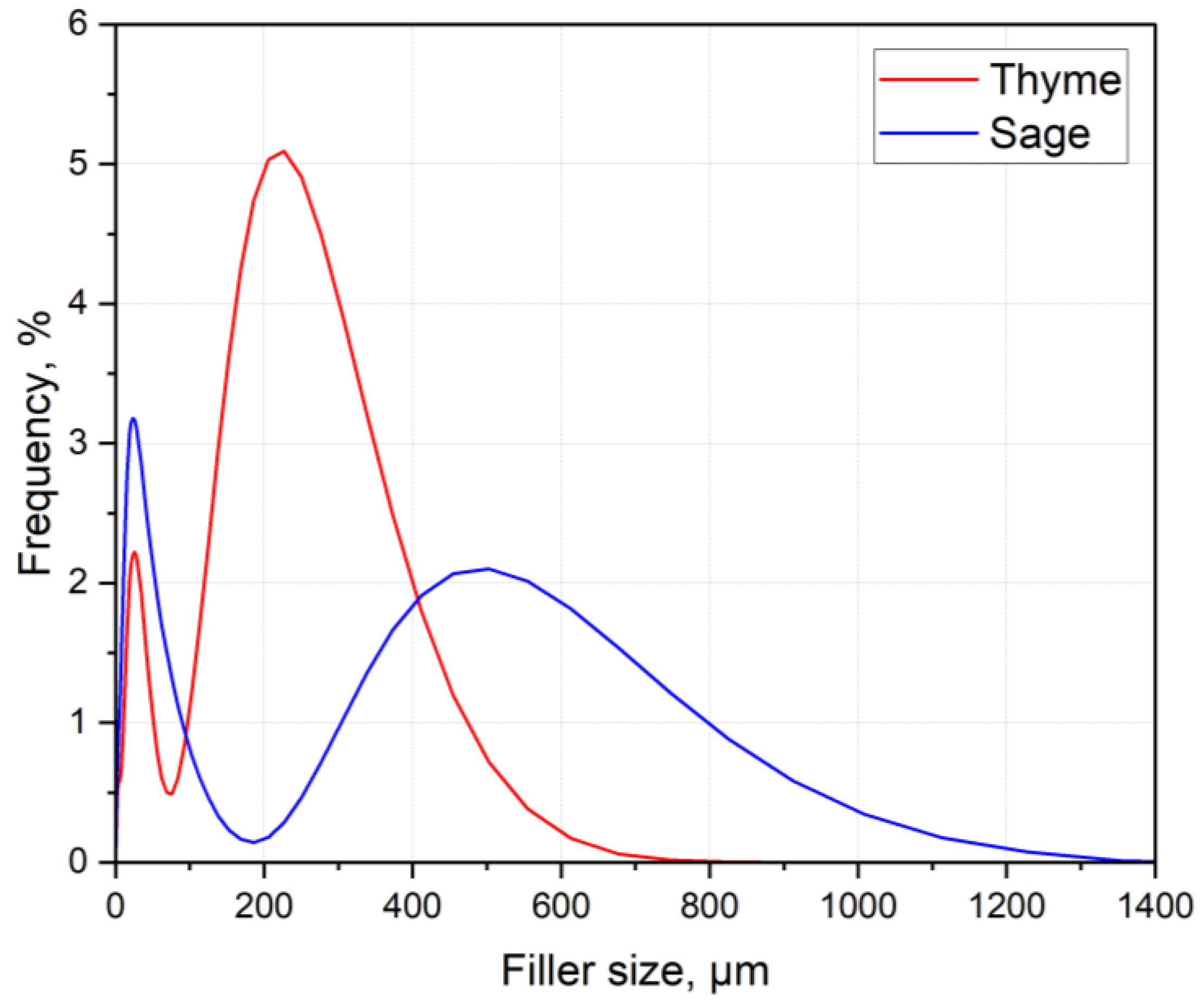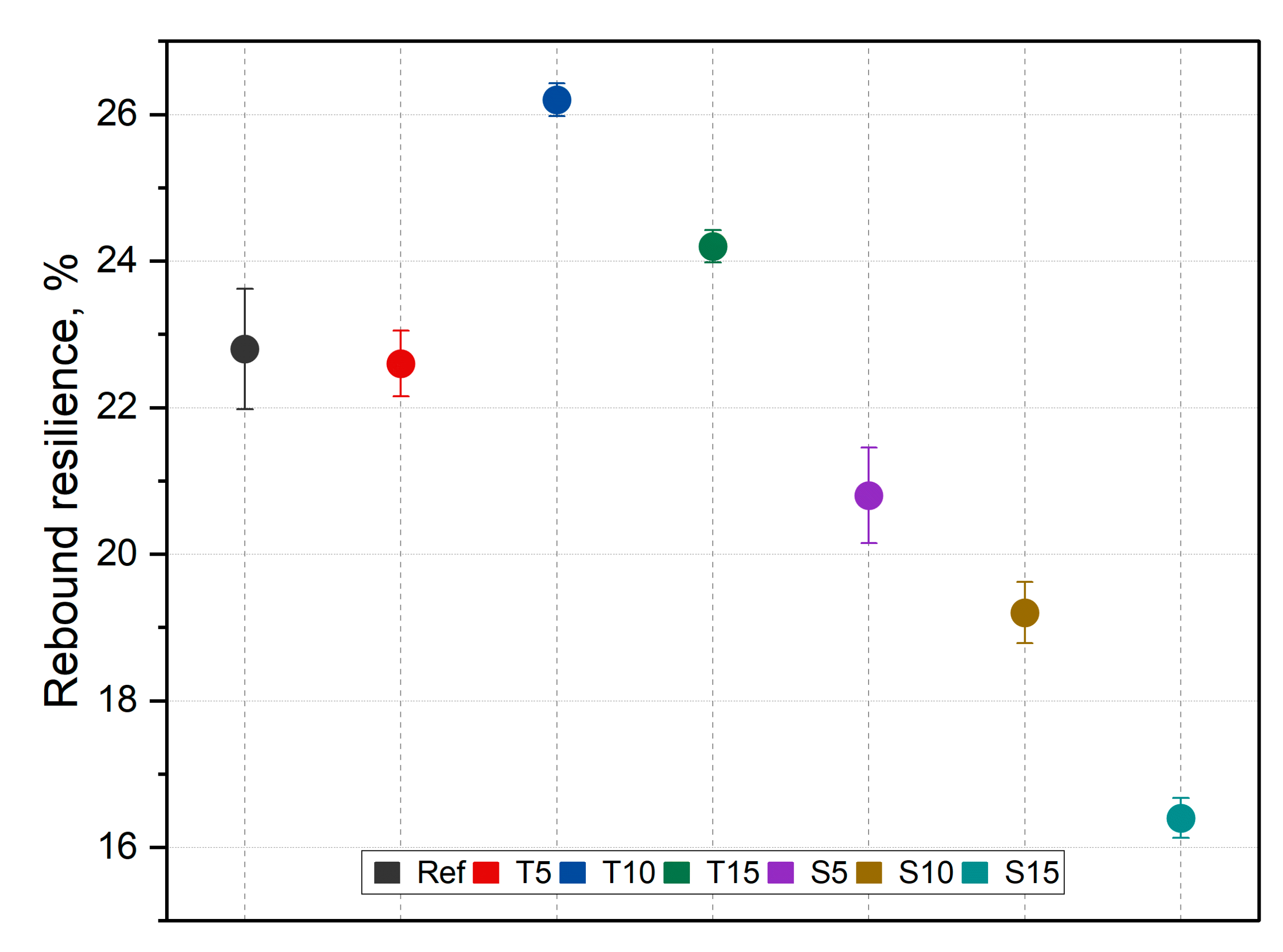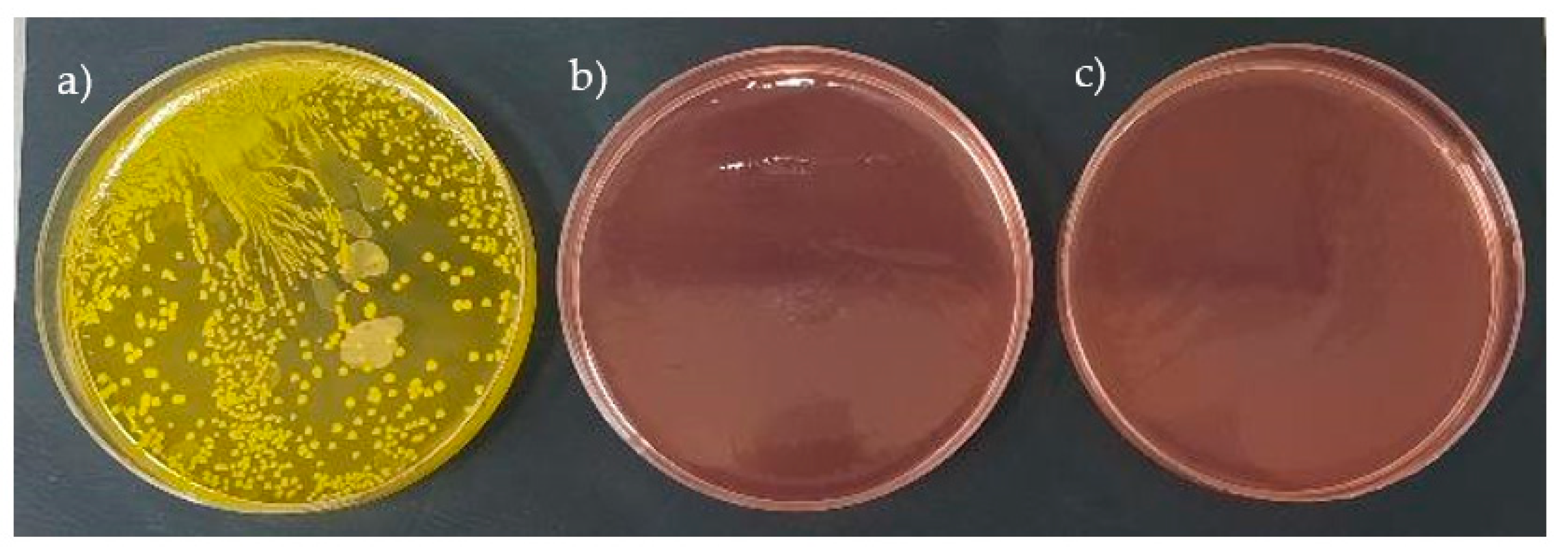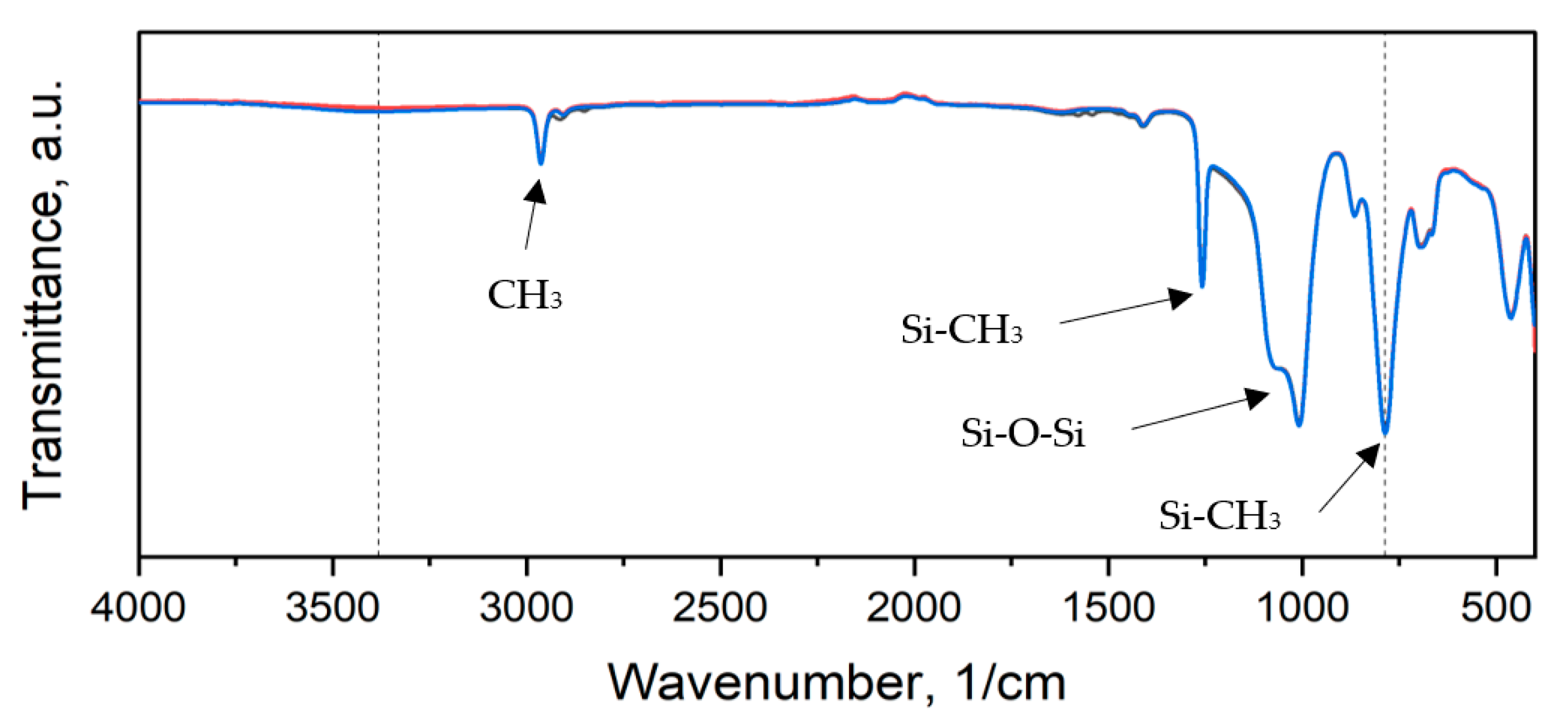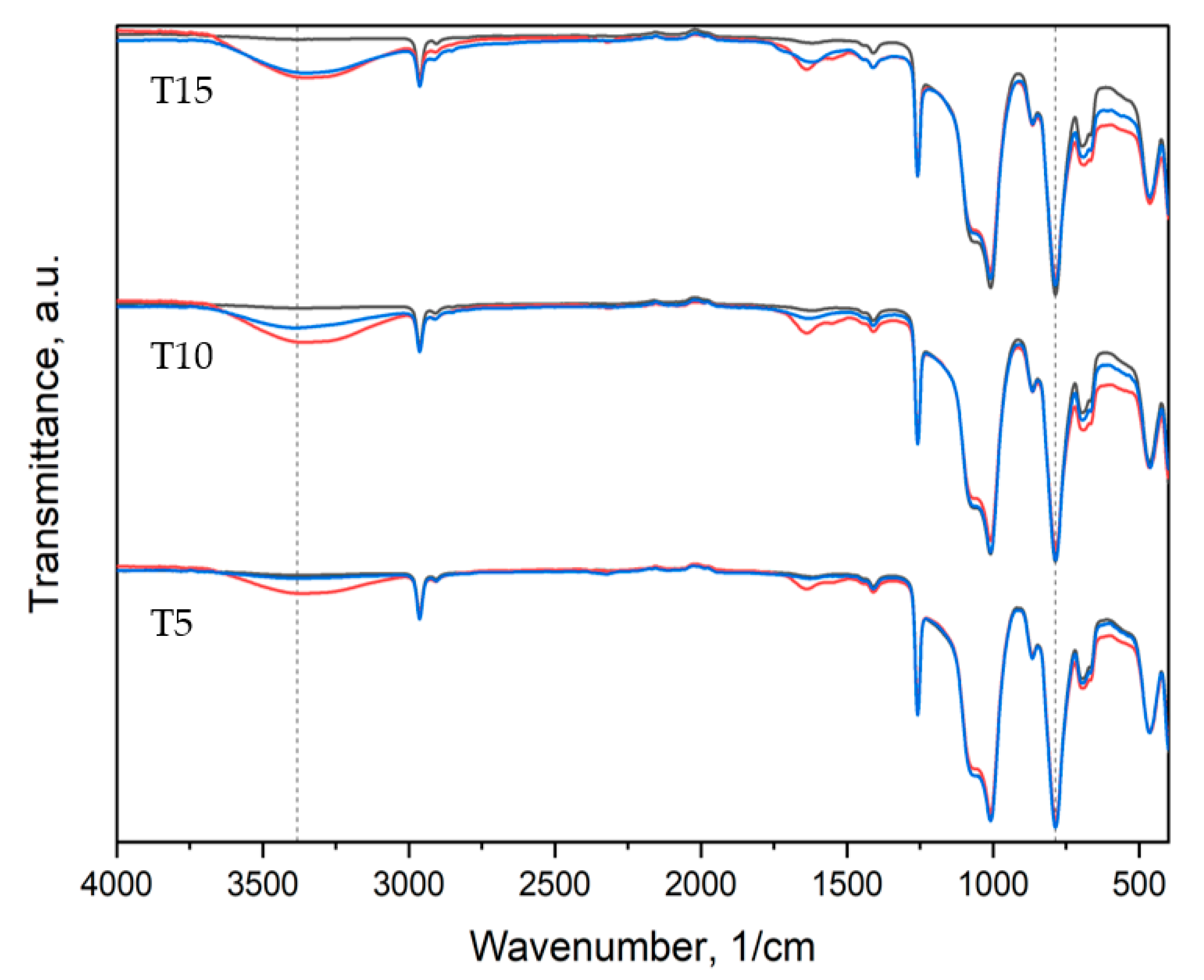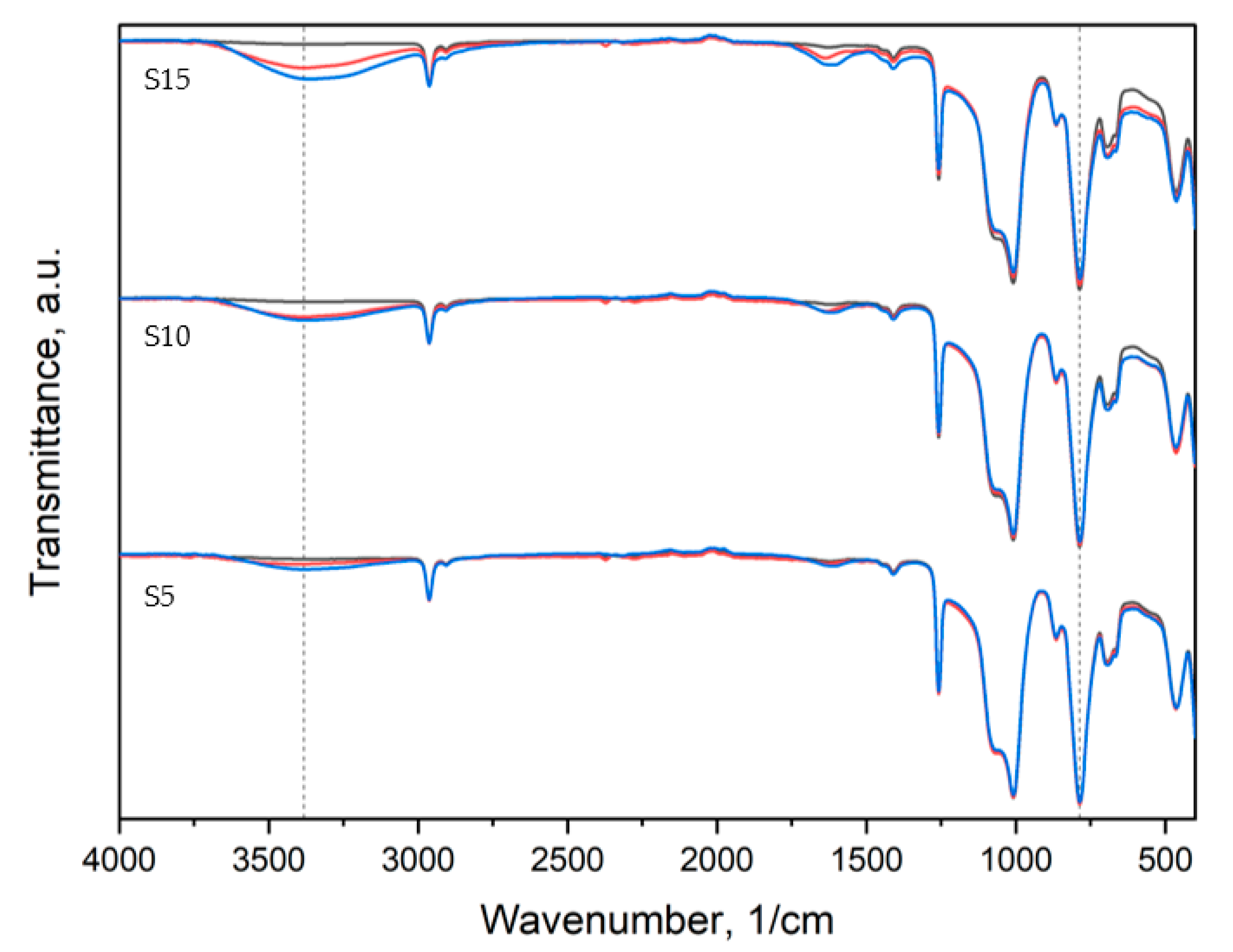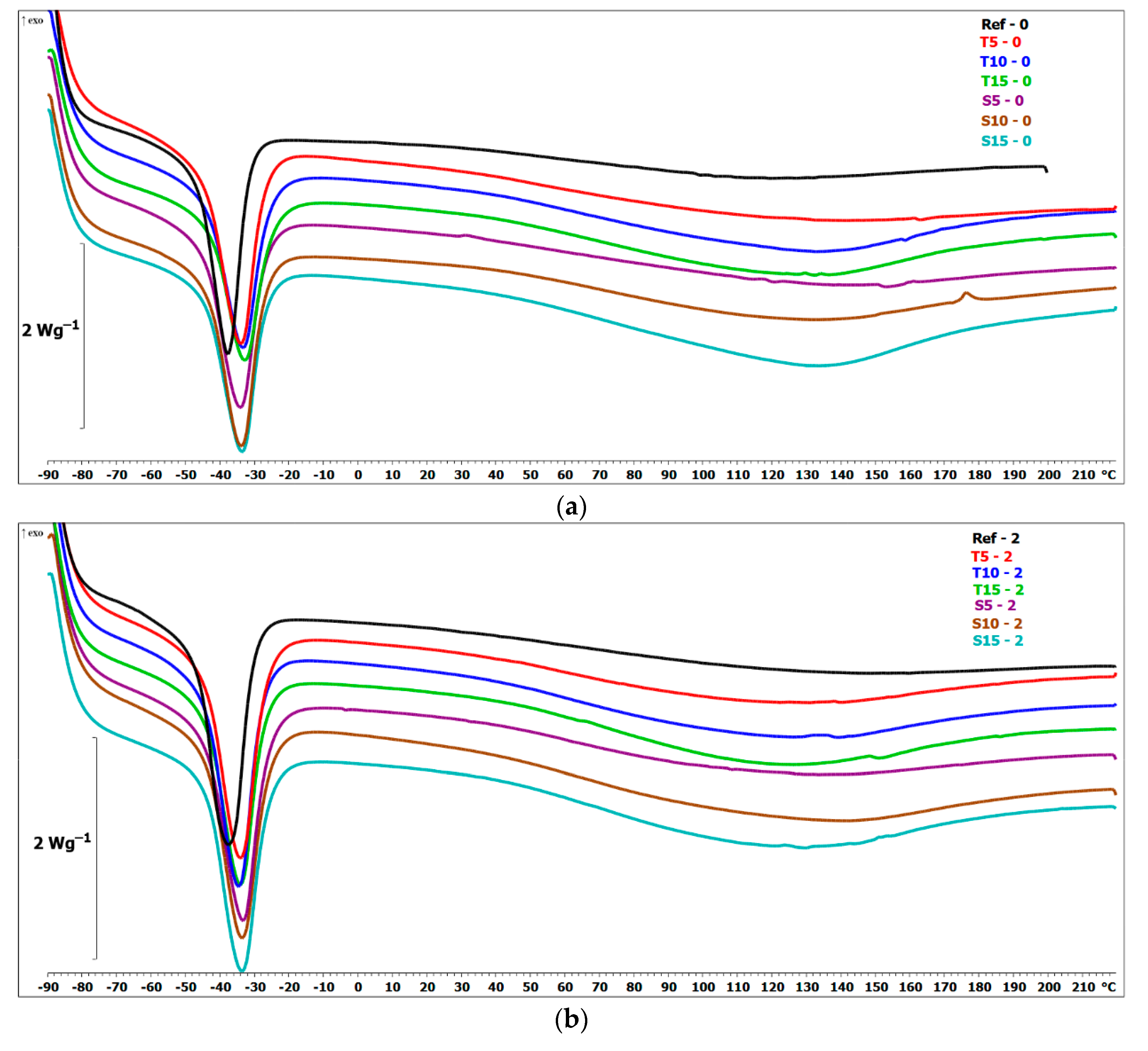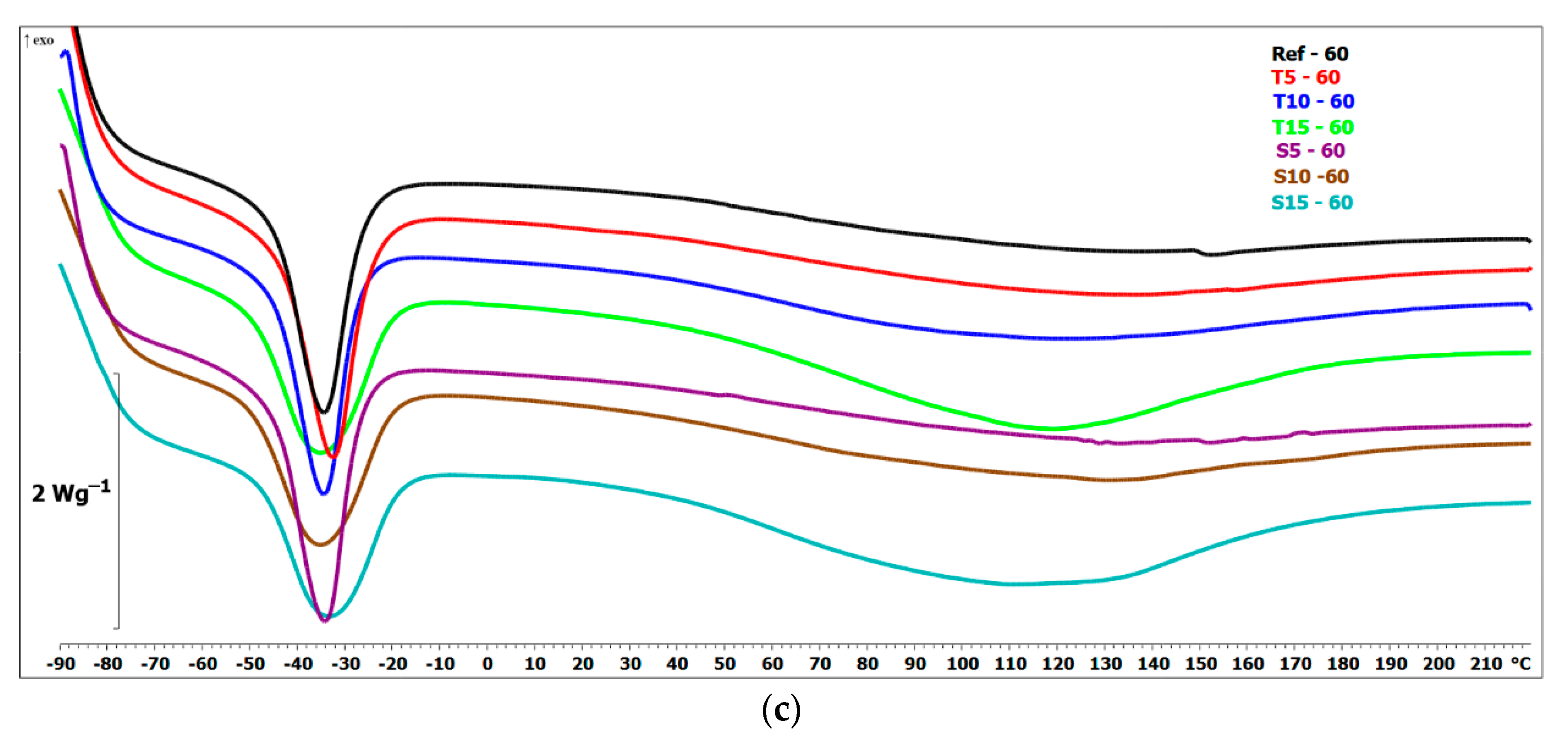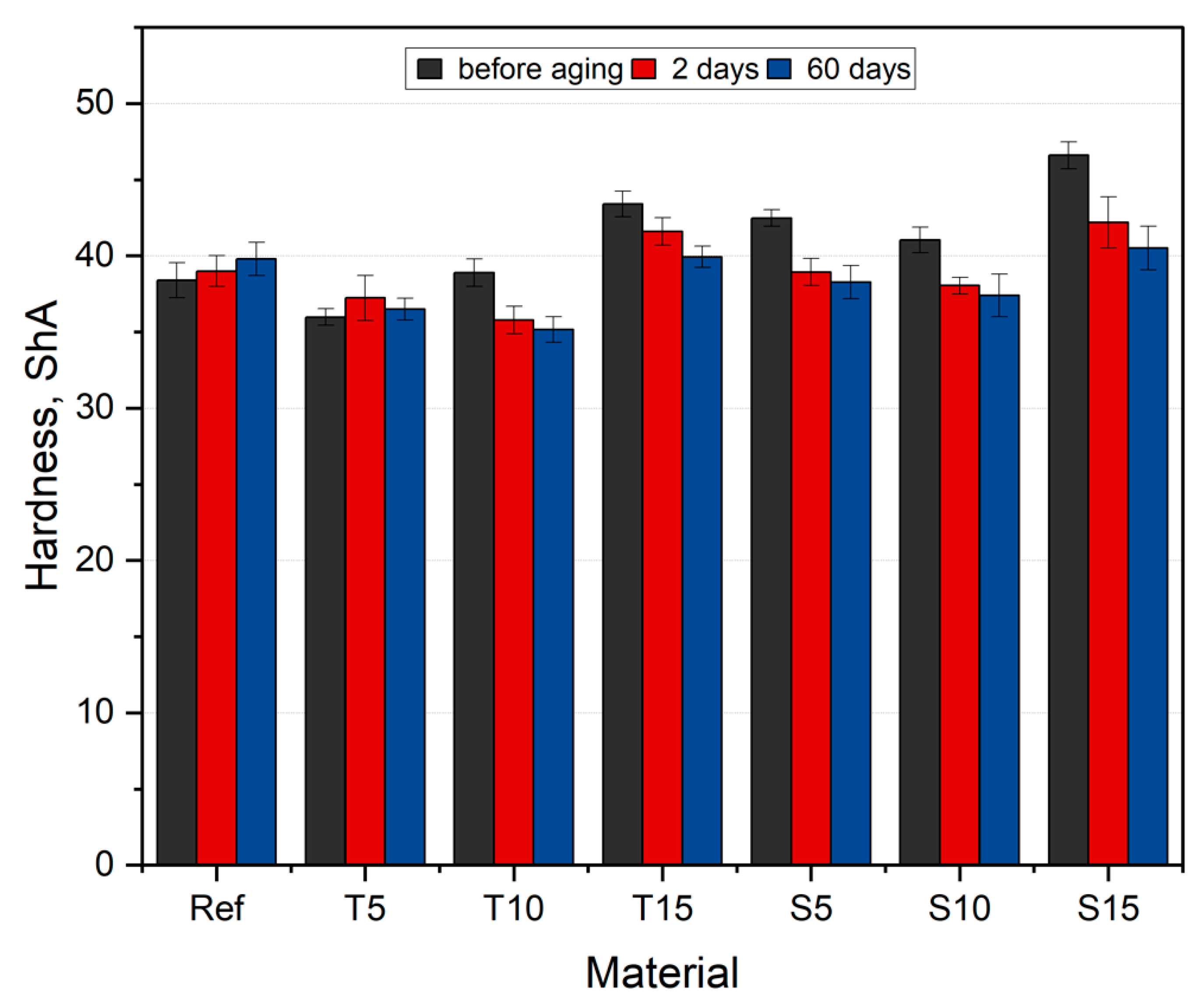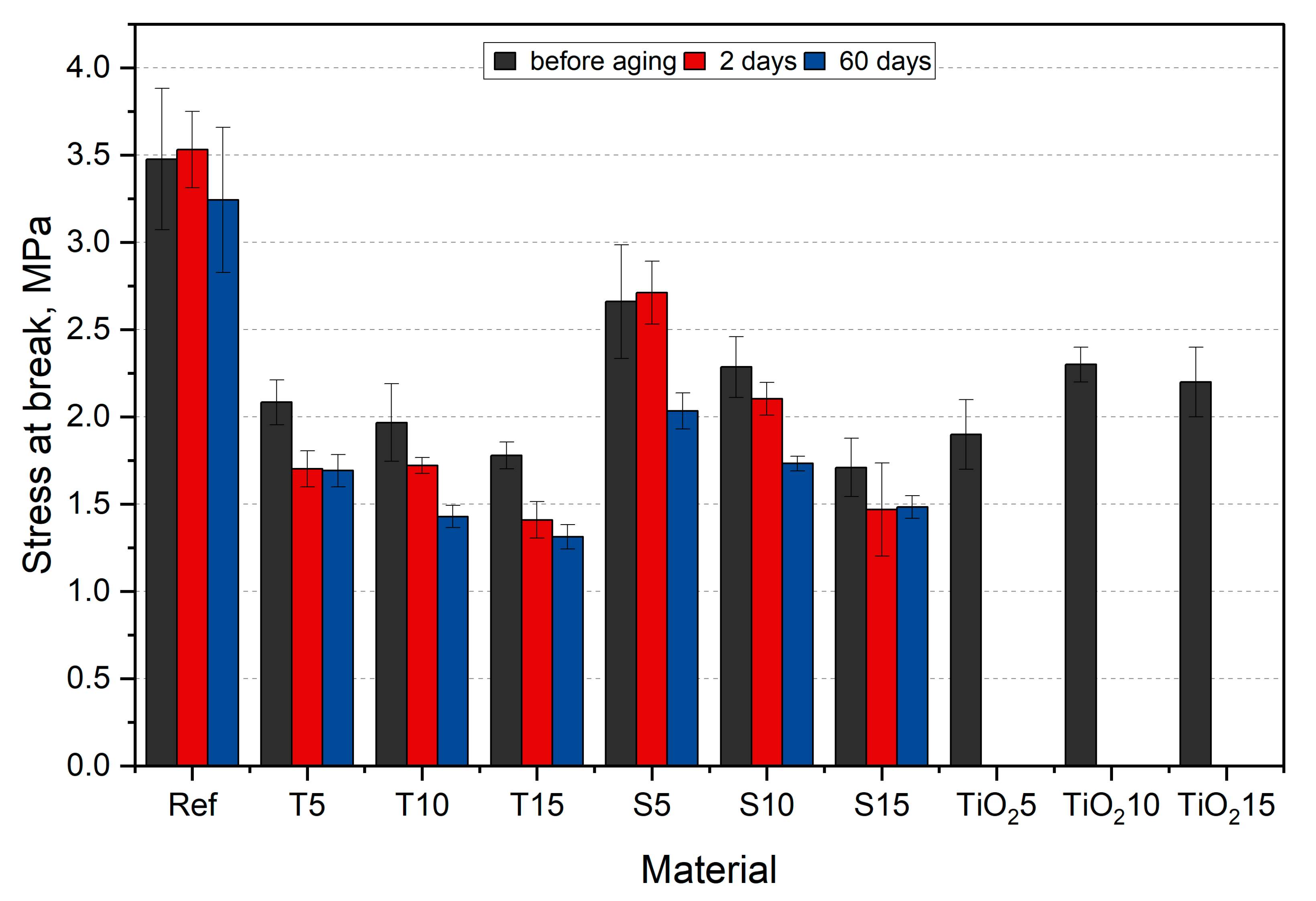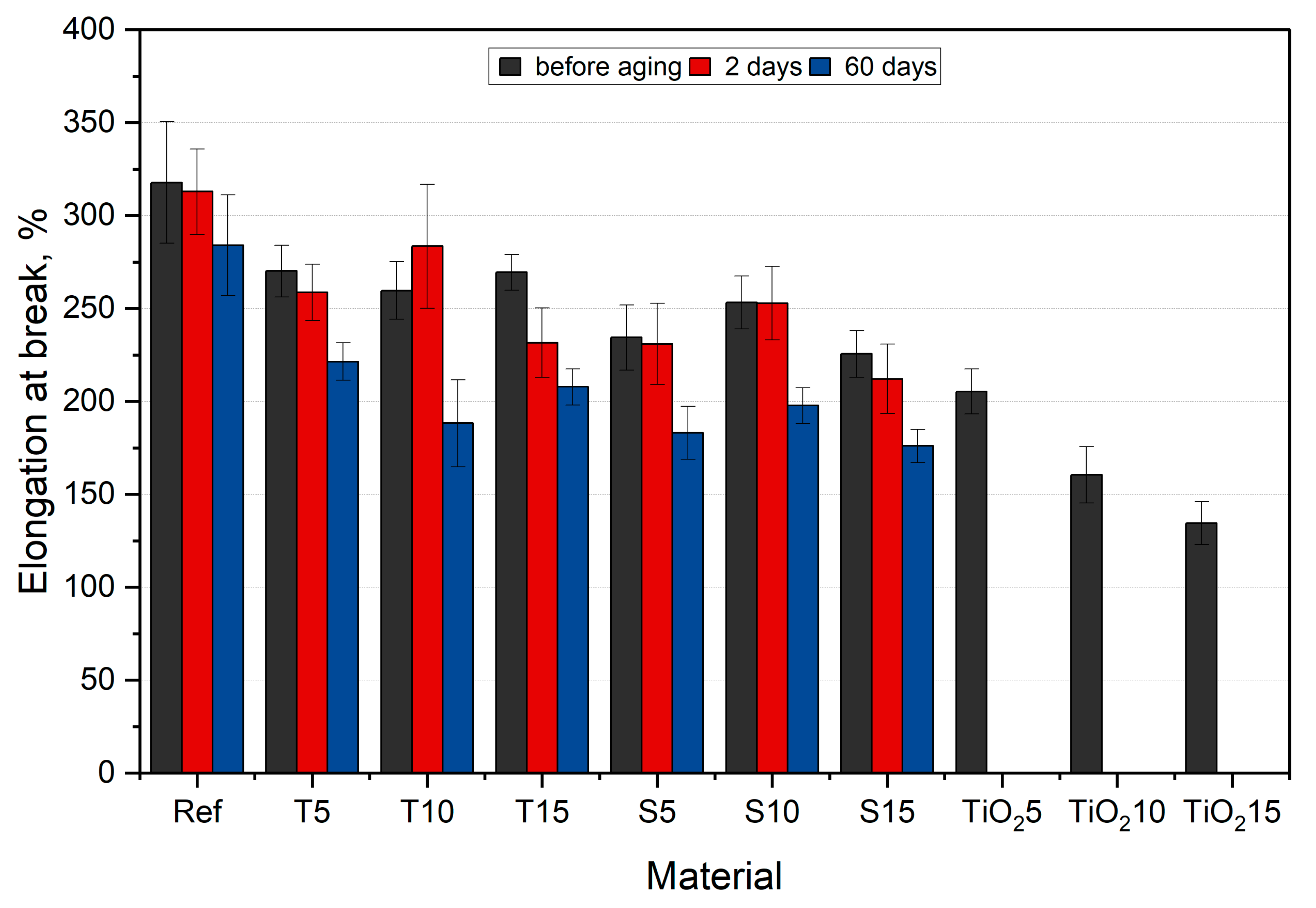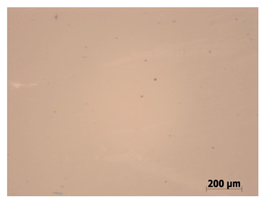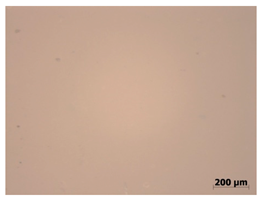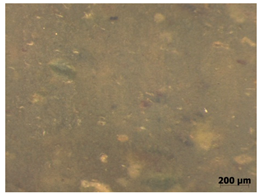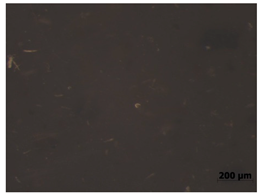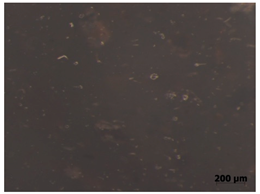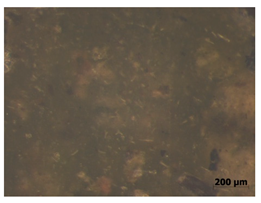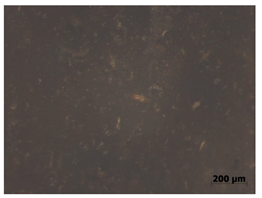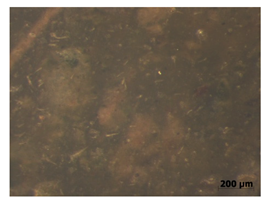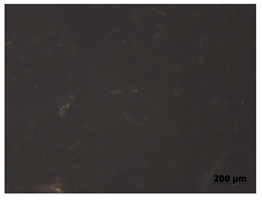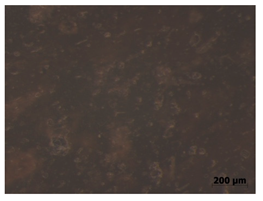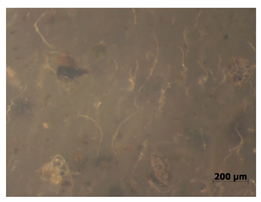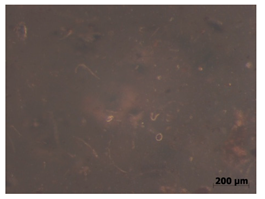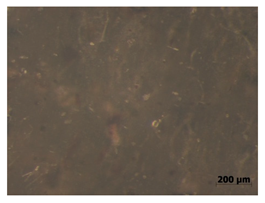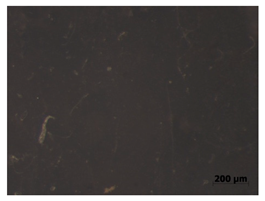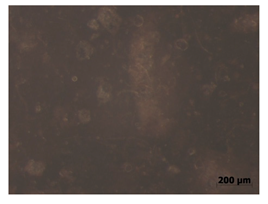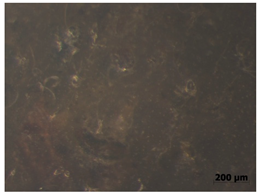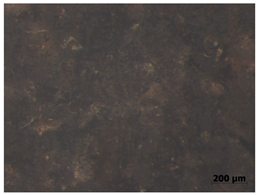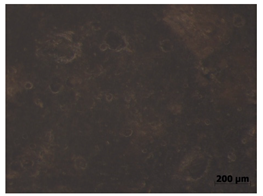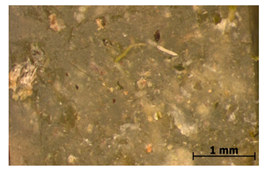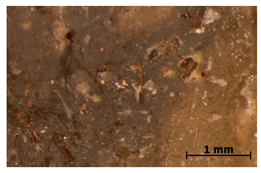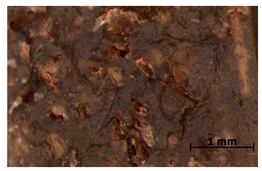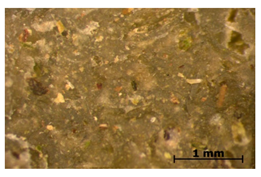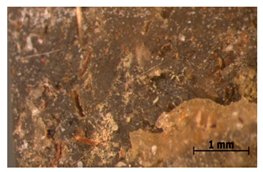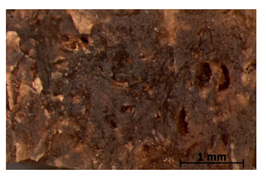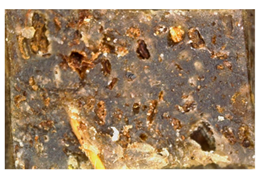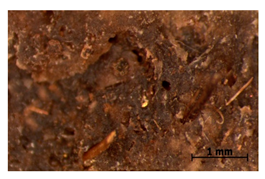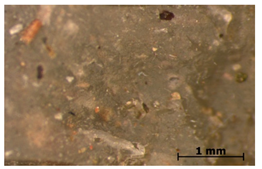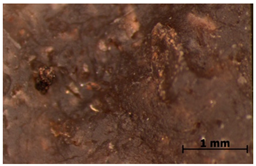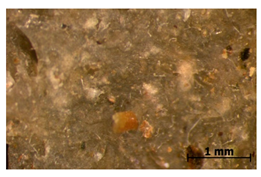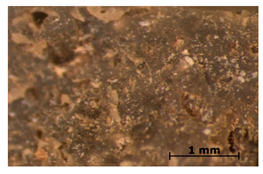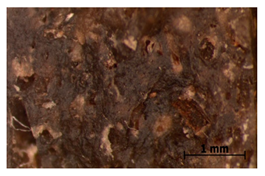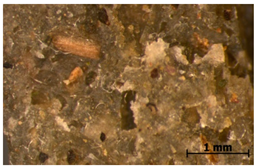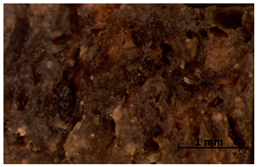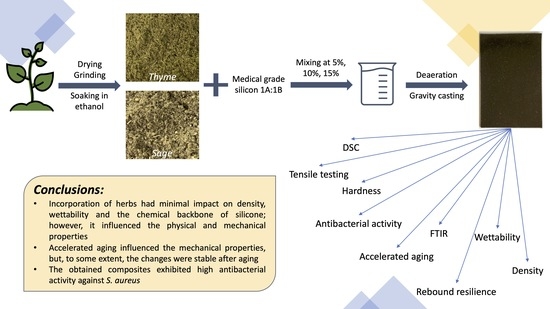1. Introduction
Unlike other polymeric materials, silicones have unique properties, such as flexibility at a wide range of temperatures, chemical stability, gas and drug permeability, and low surface tension [
1]. These properties manifest in high biodurability and biocompatibility. In the medical field, these materials have found application in short and long-term implants (e.g., urinary catheters [
2], voice prostheses [
3], maxillofacial prostheses [
4], airway stents [
5], and wound dressings [
6]), as well as medical devices and instruments. However, these materials are characterized by low antimicrobial properties, making them prone to colonization by bacteria or fungi and forming resistant biofilms. This leads to progressive infection of the surrounding tissue, causing severe health problems.
Recent developments in medicine have heightened the need for biomaterials fulfilling not only the basic functional requirements, but also limiting the expansion of microbial colonies on their surface. Scientists are constantly seeking new means to improve these materials. Literature reports different ways of achieving better mechanical properties, improved antimicrobial properties, or both. The modifications can be either made to the structure of the silicone matrix, i.e., by incorporating fillers or by coating the material. Many works reported the favorable impact of coating the silicone surface with sophorolipids [
7], R89 biosurfactant [
8], nanogold [
3], and silver nanoparticles [
9] on the antimicrobial properties. However, this kind of modification mainly limits bacterial or fungal colonization and has little impact on the mechanical properties. On the other hand, mechanical properties can be influenced by incorporating graphene and carbon nanotubes [
10,
11], silver-zirconium phosphate and titanium oxide [
12,
13], titanium dioxide [
14], zinc oxide [
15], PMMA [
16], or bioglasses [
17,
18], some of which improve the antimicrobial properties and biointegration of implants as well. Another way to reduce the adhesion of bacteria to the material is to modify the surface by interacting with chemical compounds, plasma or nanopattering, which allows for obtaining a specific surface topography [
19,
20,
21].
Nevertheless, the modification methods mentioned above need chemical preparation before incorporation. This generates higher coats and often involves using harmful chemicals. With that in mind, researchers are turning towards acquiring composites incorporated with organic fillers owing to their adequate properties, such as availability, renewability, and simplicity of preparation, compared to inorganic fillers. Multiple works reported the changes in the silicone matrix after incorporating it with different organic materials. Some studies proved their favorable impact on mechanical properties [
22,
23], and others, the opposite [
24]. The results varied depending on the filler type, fraction, and structure.
Another approach is to incorporate plant extracts highly rich in phytochemicals called polyphenols. Polyphenols are secondary metabolites chemical compounds naturally occurring in plants and herbs. They are responsible for defense against ultraviolet radiation and pathogens’ aggression and contribute to the plant’s color, flavor, and odor [
25]. Maroufi et al. [
26] successfully incorporated thyme extract into an electrospun polylactic acid and proved their favorable impact on the mechanical and biological properties. Multiple researchers achieved similar results using different herbal fillers [
27,
28,
29,
30]. In a different approach, researchers incorporated thyme in a powdered form. In one work [
31], incorporating thyme had a beneficial influence on mechanical properties; other works stated the opposite [
32]. The difference in the results is related to the varying filler size and matrix material.
In the case of materials modification, an essential factor is the analysis of their behavior and changes in characteristics during use. For this purpose, accelerated aging tests are carried out in simulated conditions similar to the working environment. The majority of these procedures are performed under elevated temperatures. This causes the formation of cross-linked structures. Water vapor reduces the molecular weight, and gamma radiation affects the oxidation of siloxane [
33,
34]. The degradation process depends on the chemical structures, the modification type, and the product manufacturing technology [
35].
However, to the best of our knowledge, limited works study the impact of the direct incorporation of polyphenols-rich herbal fillers into an organosilicon polymer matrix, which the authors took upon themselves to investigate.
This paper will focus on the possibility of developing new silicone biocomposites incorporated with powdered herbal fillers and evaluating the changes occurring in the polymeric matrix. The assessment will be based on several physical, chemical, biological, and mechanical tests. Moreover, the materials will be subjected to accelerated aging in a solution simulating the human extracellular fluid.
3. Results and Discussions
3.1. SEM Observations
The fillers’ grains shape is illustrated in
Figure 5.
Both fillers have developed surfaces with structures of different sizes. In thyme micrographs (
Figure 5a), the grains are characterized by bent, unbranched, needle-like trichomes (structures responsible for protection and odor) with a rough surface and visible stomas. At higher magnification, it can be observed that the trichomes are opened. This is related to the grinding process, due to which the trichomes release an odor characteristic of thyme. In addition, grains’ sizes vary from smaller, shorter structures to bigger, longer ones, which is proved in particle size analysis in
Section 3.2. In addition, the grains exhibit extensive internal structures showing high porosity, affecting the matrix’s adhesion. Like thyme, sage’s grains are characterized by visible stomas and trichomes; however, they are longer and form a far-reaching net rather than multiple assemblages (
Figure 5b). The differences between the fillers are mainly related to the nature of the plants and their individual behavior during the grinding process. It should be noted that despite the purchase of dried fillers and then subjecting to additional drying, the method used for drying fresh herbs, which may additionally affect the grinding behavior of the herbs, is unknown to the authors. The well-developed surface of the fillers is one of the main factors influencing the properties of the obtained composites. Moreover, thyme stalks are highly branched (after years, they become woody), and the leaves reach a size of up to 4 cm. Woody stems affect the properties due to increased hardness. In the case of sage, the leaves are mainly used and do not show any woody parts, which does not significantly affect the test results. Woody parts can act like a notch, affecting the results’ scatter [
47].
3.2. Grain Size
Particle size analysis results illustrate the fillers’ grain size and distribution based on five measurements of each material (
Figure 6).
Both fillers show bimodal grain size distribution consisting of fine and coarse grains. Sage grains are characterized by a more uniform distribution between the largest and the smallest particles. In thyme’s case, the most common size is 227 µm (6.62%), while for sage, it is 23 µm (3.4%). However, the 90th percentile of thyme grains equals 281.73 µm, whereas, for sage, it equals 471.12 µm, making sage grains bigger than thyme by approx. 67%. The differences in the herbs’ grain distribution are attributed to their individual behavior during the grinding process. The grain distribution and morphology play an essential part in structure forming and, hence, properties’ shaping.
3.3. Density
The average density results are presented in
Figure 7.
The density of the obtained composites differed from that of silicone, which is also related to the bulk density of herbal powders—approx. 0.29 g/cm
3 [
48]. The density of pure silicone was 1.08 g/cm
3, and for the highest fraction, it changed to 1.1 g/cm
3, so it could be concluded that the density depends on the content of the herbal powders. However, the differences are within the error limits. Statistical significance was found (F (6,28) = 26.86,
p < 0.001); however, post hoc analysis revealed that the change is only significant in composites with 15 wt.% of thyme and sage. This may be due to the fact that these composites have a higher filler fraction than the rest, and due to the hygroscopic nature of the herbs, the materials are more prone to absorbing moisture, which affects the bulk density. In addition, the content of the woody parts may be an important factor that could potentially influence the standard deviation. The highest standard deviation was observed for composites with higher contents. The presence of moisture is also related to the powders’ structure.
3.4. Wettability
The contact angle results are presented in
Figure 8.
The incorporation of thyme increases the silicone surface contact angle, and the higher the filler fraction, the bigger the contact angle value. The opposite is observed for sage-filled composites. This is undoubtedly related to the herbal composition (the content of the desired compounds). Sage has a higher acid content than thyme, which affects the nature of the changes in properties (
Figure 2). Nevertheless, these changes are within the error limits. Although statistical analysis proved the relevance of the changes (F (6,53) = 3.68,
p < 0.001); post hoc analysis revealed that the composite incorporated with 15% of thyme alters the contact angle significantly compared to the native material, while the remaining composites’ impact is statistically trivial.
3.5. Rebound Resilience
The rebound resilience results are graphically illustrated in
Figure 9.
The resilience of the materials changes depending on the filler type and fraction. The rebound resistance value of T5, T10, and S5 composites is greater than that of silicone. The inverse proportional dependence of rebound resilience on the content is observed for the tested composites, but the values of sage composites are lower than for thyme-filled composites. These differences may be due to the shape of the fillers and the developed surface increasing the moisture absorption, which, in turn, weakens the material. Moreover, sage has a higher crude fat content than thyme, which influences the hardening process of silicone and changes its mechanical properties [
37]. The proposed modification of the fillers under the influence of ethanol partially removed the undesirable compounds, e.g., fats. This impacted the fiber and matrix adhesion and the cross-linking process. The most significant decrease is noted for S15 (approx. 19%) compared to the reference samples. One-way ANOVA analysis found the changes to be significant (F (6,28) = 56.26,
p < 0.001). In relation to the native material, essential changes were noted for T5 and S15.
3.6. Antimicrobial Activity Measurements
The results of the antibacterial properties assessment are presented in
Figure 10.
It can be noticed that the Gram-positive bacteria have colonized the surface of the reference material. At the same time, the composites exhibited strong antibacterial activity against
S. aureus after 24 h of incubation. The reduction log for both composites was around 4.4. According to the standard, materials achieving a reduction log bigger than 2 are considered to be bacteriostatic. Similar, yet slightly lower, antibacterial activity was achieved by incorporating zinc oxide nanoparticles [
49] and rhamnolipids [
50] (two strong antimicrobial agents) into PDMS. Therefore, it is undeniable that the obtained material exhibits bacteriostatic activity against the tested strain. It should be noted that the composites with the highest content of thyme, T15, and sage, S15, were tested because it was assumed that if the matrix material is certified for skin applications, the highest contents will be the most sensitive.
3.7. Accelerated Aging
The surfaces of the native and aged samples are presented in
Table 4. It should be pointed out that the microscopic observation was performed on the samples after undergoing tensile testing. As can be seen, the surface of the reference material remained the same after aging. In the case of composites, after 2 days of aging, a white deposit is observed on the surface which increases after 60 days of aging. The accelerated aging process conditions led to the precipitation of salts and their adherence to the surface of the samples. This is mainly related to the aging process being carried out in a water-baes salt solution. It should be noted that due to the fact that the studied reference material was translucent, such observation was unfeasible. The solution in which the composites were aged changed its color to light green, indicating that some of the fillers’ compounds dissolved.
3.8. ATR-FTIR
All samples exhibited peaks corresponding to Si-O-Si, CH
3 rocking and bending in Si-CH
3, and C-H stretching in CH
3 bands characteristic of PDMS [
51]. The reference material spectrum remained almost intact after 2 and 60 days of degradation. The peaks corresponding to Si(CH
3)
2 stretching and Si-O-Si stretching are of higher intensity for aged samples (
Figure S1, supplementary materials).
For thyme and sage composites, the spectrum of the native samples changes with aging days. Peak intensity at 786 cm
−1 and 1004 cm
−1 decreases after two days of aging and increases again after 60 days for thyme composites. However, in the case of T5, peaks after 60 days are bigger than in native samples. Similar behavior is observed for the light wave at around 3381 cm
−1, characteristic of the –OH group (
Figure 12). On the other hand, sage composites exhibit decreasing characteristic of PDMS peaks after aging (
Figure 13 and
Figure S1, supplementary materials). The presence of the hydroxide group in silicones’ chemical backbone decreases the material’s hydrophobicity [
52]. As seen in the materials’ FTIR spectra, the fillers’ introduction further decreased the peak corresponding to the hydrophilic hydroxide group (
Figure S2, supplementary materials). Therefore, the surface of the composites is more hydrophobic than the reference material. This explains the contact angle results presented in
Figure 7. This is crucial from the point of view of biocidal studies, the results of which are presented in
Figure 10.
3.9. DSC
Based on the data presented, PDMS exhibit an endothermic peak at −40 °C, indicating the melting of the material crystallites, which corresponds to the value reported in the literature [
53]. After incorporating thyme and sage, no other endo- or exothermic peak is observed. Moreover, the melting temperatures do not change significantly. The most notable change is observed for T15. There are certain differences between the melting temperature of unaged reference material and biocomposites. However, for the reference samples, after 60 days of aging, the value drops by 3 °C and is comparable to the melting temperatures of the composites. For all composites, the melting point is similar. Similar behavior was observed for the heat of fusion. Adding herbal fillers causes a significant decrease in enthalpy of fusion for composites with 15 wt.% of thyme or sage filler. This effect can be explained by the fact that the presence of the herbal filler particles restricts the nucleation process of polysiloxane. This affects the organization of the crystals leading to the formation of a less crystalline phase within the polysiloxane matrix [
54]. Moreover, after 60 days of aging, the enthalpy value slightly decreases compared to the unaged samples. Only in the case of T15 does the value increase after aging. The determined values for individual samples in the first heating run remain almost the same after the second. Accelerated aging had a trivial effect on the tested properties. Nevertheless, adding 15 wt.% of thyme significantly decreased the enthalpy of fusion.
3.10. Hardness
The hardness average results are illustrated in
Figure 15.
All materials exhibit higher hardness than the one stated by the manufacturer (30 ShA). The hardness of the composites has changed compared to the reference group. However, there is no clear relationship between the filler content and type. All samples, except for T5, show a greater hardness value compared to silicone. The biggest increase in value is observed for S15, and the biggest drop in value is observed for T5. An increasing tendency is observed for unaged thyme composites. For T5, the hardness drops by approx. 7%, for T10, it increases by approx. 1%, and for T15, the increase is approx. 11% compared to unmodified material. S5 and S10 composites show a hardness decrease of 3.5% on average, but S15 composites are characterized by a hardness 13% higher than native samples. This is related to the content and distribution of the filler in the matrix, also after the aging period—
Figure 15. For all composites, except for T5, hardness decreases with increasing aging days. The biggest decrease is observed for sage composites, where hardness value drops by around 13% after 60 days of aging. The absorbed water-based PBS solution affects the fillers’ homogeneity, confirmed by the FTIR spectra (peak height change around 3381 cm
−1, characteristic of the -OH group). Hence, smaller series deviations are also observed. As aging progresses under the assumed conditions, the hardness decreases in direct proportion. The longer the aging time, the lower the value. The two-way ANOVA analysis showed a significant influence of both the type and fraction of fillers on the hardness value during aging (
p < 0.05). Increasing hardness value with aging days can be observed only in the case of reference material.
3.11. Tensile Testing
Illustration of the cross-section at the fracture point of thyme and sage composites samples is presented in
Table 5. As can be seen, during tensile testing, thyme and sage particles tended to detach and leave voids that acted like notches leading to weakening of the materials. Moreover, the observed changes in topography (
Section 3.7) are also observed in the internal structure of the composites.
Graphical presentation of the calculated stress at break and elongation at break values are presented in
Figure 16 and
Figure 17, respectively.
After incorporating organic fillers, the smallest drop in stress at break value was observed for S5 (23%), while the biggest drop in value was observed for S15 (49%). The range of value drop for thyme composites was smaller than that of sage composites (from 40% for T5 to 48% for T15). Such large differences observed for composites with thyme result mainly from the method of preparing herbal powder, in which, apart from soft ground leaves, there are also woody stems (
Table 5). Moreover, the properties could be influenced by the agglomeration of the fillers, which act as notches and significantly influence the obtained values. In the case of composites with sage, there is a smaller decrease due to the fact that the leaves and soft stems were selected before the powder preparation. Moreover, as already mentioned, an important factor influencing the tested properties is the herbs’ composition. Similar results were obtained by Mirabedini et al. [
55] (presented in
Figure 16 and
Figure 17 for reference purposes). The researchers incorporated a room-temperature-vulcanizing silicone (RTV) with TiO
2, an additive that is known to have antimicrobial properties. They observed a decrease in stress at break and elongation at break. The values averaged between 2 and 2.3 MPa correspond to the results obtained in this work. Moreover, Xu et al. [
56] reported a study where they obtained an antimicrobial dressing exhibiting similar mechanical properties to ours.
The reference sample’s stress at break increases by approx. 2% after 2 aging days and drops again by 7% after 60 days. Similar behavior is observed for S5 samples. S15 samples after 60 days of aging have the lowest stress at break, dropping by 54% in relation to the aged silicone. The most significant impact of aging on the stress at break value is recorded for T15 samples, where the value drops by 26% after 60 days compared to the unaged samples. The drop in stress at break results after aging corresponds to the decreasing peaks in the materials’ IR spectra.
All materials, except for T10, show a decreasing tendency of elongation at break value with increasing aging days. For native samples, the highest value drop is observed for S15 (29%), while the lowest drop is observed for T5 (15%). For reference, the TiO
2-filled PDMS exhibited lower elongation at break compared to the studied materials [
55]. Among aged composite samples, T10 has the highest elongation at break value, while the lowest is characterized by S15. Sage composites exhibit a similar drop in value after 60 days of aging for all fractions (around 21%). The conducted statistical analysis proved the impact of the filler and aging time on the tensile strength (
p < 0.05).
As aging progressed, the stress at break decreased, and so did the elongation. However, a smaller scatter of results is observed, which indicates a more homogeneous structure resulting from the influence of the research environment. This is confirmed, as already mentioned, by the FTIR spectra. The absorbed medium affects the fillers by softening them, thus minimizing the influence of more rigid particles.
3.12. Multiple-Criteria Analysis
In order to assess the obtained materials, a multiple-criteria analysis (
Table 6) was carried out based on the tested properties’ results. The weights were determined based on the influence of the tested characteristics on the operational properties of the materials. The properties, based on their importance, were given a value that ranged from 1 to 7. It should be noted that the antibacterial activity results were not included in the analysis due to the fact that only composites with the highest fraction of fillers were tested.
Based on the multiple-criteria analysis it can be concluded that among the obtained materials, composites with the lowest filler fraction had higher characteristics compared to composites with bigger fraction. S5 had the highest score among the obtained composites.
